
The women’s liberation movement of the 1960s and 70s found a home in science fiction in the 1976 Anglo-German series, Star Maidens. Conceived by Graf and Graefin Von Hardenberg with the backing of the Jost von Herdenberg Corporation of Frankfurt, Germany, the series was shot on 16mm film by Portman Production at Bray Studios in England for broadcast throughout the United Kingdom. Since the producers couldn’t secure a steady time slot for the series, it was filmed as a serial, with a budget of $75,000 USD per episode. Episodes were aired sporadically as time slots could be secured.
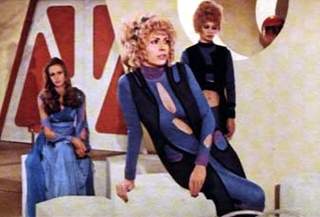
The premise concerned the planet Medusa, a technologically advanced world originally in the Proxima Centauri solar system, where women were dominant and men were demoralized slaves. Meant to show role reversals and send a clear message for women’s liberation movements worldwide, Star Maidens was spiced up with sexy women enthralled in both love and lust for the men they dominated. The result was a tongue-in-cheek, low-budget space opera whose galactic settings looked remarkably similar to those from the hit British series, Space: 1999. This wasn’t a coincidence.
Keith Wilson, who worked on both seasons of the Gerry Anderson series, was hired on Star Maidens as the production designer. In that role he reused a lot of the Space 1999 models fragments and set elements. To compensate for the extremely low budget, Wilson scrounged everything he could from earlier shows, exploiting what wasn’t prohibited under international copyright laws and making back room deals to use things that were. His work was admiral, even though it often resulted in haphazard creations whose flaws sometimes became too apparent.

For example, the model sets of the Medusan city looked impressive at first glance. On closer inspection it became apparent that they were made almost entirely out of common items like table tennis balls, plastic straws, sewing thread reels, egg cartons, and the like. Compounding the problem, the establishment shots that showed these models revealed them a bit too long for the flaws not to become apparent to even the most unobservant viewer.
Wilson was also responsible for most of the spaceship designs including the Nemesis, a snail-come-slug shaped machine, and a drone patrol vehicle, used to monitor the workforce on the inhospitable surface of Medusa. Like the models of Space 1999, built under the direction of expert modelmaker Martin Bower, the spacecraft model work in Star Maidens was extremely well done and is one of the strongest elements of the series.
The storyline of the series begins when two men escape from the planet Medusa in a stolen spacecraft. They are pursued and narrowly avoid being killed by crash-landing on Earth. They appeal to the Earth authorities to allow grant them asylum from the pursuing women. While explaining their case, the spokesman, Adam (Pierre Brice) explains that he is a leader in the ‘Men’s Liberation Movement’ fighting for men’s equality. On Medusa, all men are considered servants, although slaves would be a better term for their role. They play no part in the government and are not allowed to hold any jobs more responsible than that of a cook or gardener. Consequently, the majority of Medusan men are not intelligent and have become pre-conditioned to accept a women’s commands without question.
Adam has long wanted to get to Earth and executed his escape with help from Shem (Gareth Thomas), whom he had to bully into assisting him to pilot the stolen spacecraft. They have been pursued by Medusa’s Chief Security Controller, Octavia (Christiane Kruger) and Adam’s mistress Grand Councilor Fulvia (Judy Geeson) who control the spacecraft Nemesis.
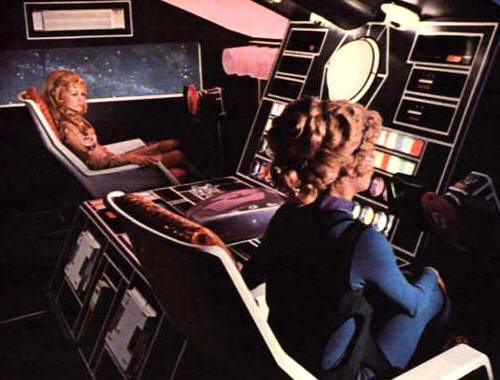
Fulvia simply wants her servant returned. She regards him as her pet and fears that he’ll come to harm outside here care. Octavia has wider concerns. She is irritated that any planet, even one as backwards as Earth, allows men positions of responsibility. Its an intolerable situation that must eventually be changed. Her perception is amplified when the Nemesis lands on Earth and the two Medusans are confronted by policemen. Octavia immediately begins ordering the policemen around and is angered when they don’t respond in the obedient manner of Medusan men.

The interplanetary incident draws the attention of Doctor Rudi Schmidt (Christian Quadflieg) of the Astronomical Institute. He rushes to the landing site with his assistant, Liz (Lisa Harrow) only to discover the spacecraft empty. He and Liz board the vessel and begin investigating. Schmidt accidentally triggers a device which blinds him. When the Medusans return, the panic-stricken Liz begs them for help. They activate their medical android, an automaton in female form with pale grey skin and surgical instruments concealed within each finger. The robot corrects the blindness leaving Schmidt perfectly healed. Having failed to get the escapees, Octavia opts to kidnaps the two scientists in order to arrange an exchange for Adam and Shem.
By this point, the male Medusan fugitives have found refuge with Professor Evans (Derek Farr) who has been interviewing the aliens in his never-ending quest for more knowledge. Like the alien renegades, he is a weak-willed character overshadowed by the Medusan men who seem unable to cope with or comprehend anything that is happening around them.
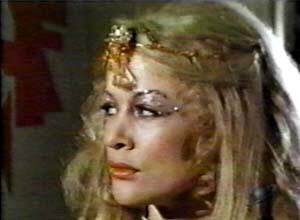
Fulvia ventures out to arrange for the prisoner exchange. Her plan is foiled when she is kidnapped by a foreign power who wants the secrets of Mendusa’s advanced technology. She escapes back to the Nemesis. Once on board, she decides that she’s been through enough. She and Octavia lift off and set course for Medusa.
On the way, Dr. Schmidt attempts to debate Octavia on the merits of their female dominated society. She does not take the challenge well. Upon arriving at Medusa, she has Schmidt placed on trail before a panel of judicial computers. They find him guilty and have him sent to a barren region where he is forced into a servant work detail conducting the most menial labor.
Sensing that these workers are the best likely source to resist the female oppression, he organizes a breakout, during which they successfully destroy a hovering patrol vehicle by reflecting its own ray back against it with a mirror. The escape is on the brink of succeeding when it is foiled by the Medusan President Clara (Dawn Adams), who orders the revolt to cease. The males preconditioning causes them to obey her orders. They surrender to red-helmeted female security guards with paraguns, a ray weapon that causes temporary paralysis. The problem solved, Schmidt learns the man’s place in the Medusan world.
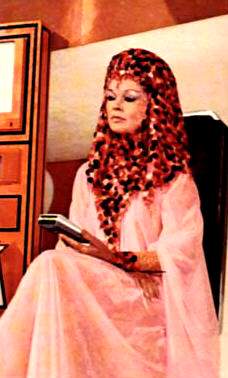
Fulvia determines to retrieve her servant and takes the Nemesis back to Earth. It is stuck by lightning and disabled, forcing her to blend into the local population. She locates Adam who refuses to return to Medusa. Facing her changed circumstances, she opts to try to live on Earth with Adam in a normal married relationship, acting as man and wife. Fulvia gains employment and soon finds herself heading off to work while Adam remains at home to do the housework. The situation deteriorates when she begins to return from a long day of work only to find Adam entertaining a group of female neighbors . Fulvia becomes jealous and the two argue about her having to do a hard day’s work while he has to slave over a hot stove. Frustrated with not being considered an equal, Adam packs his bags and leaves Fulvia. Frustrated, Fulvia contacts Medusa and has a rescue ship dispatched to retrieve both her and the Nemesis.
Meanwhile, on Medusa, an ecological disaster is brewing. Long ago, a comet passed close to Medusa and set about a shift on its axis, forcing it to be pulled free of its natural orbit and move away from the Proxima Centauri system, to drift through space and ultimately settle just outside the Earth’s Solar System. Since this ordeal, the planet’s surface was devastated, forcing the Medusans to build underground, mining out gigantic areas into which they built huge cities. The Medusans have since continually dumped chemical waste topside that gives off toxic fumes.
At his prison, Rudi Schmidt is caught in a downpour that turns the ground into thick mud and produces a brightly colored slime. Being a trained geologist, Schmidt has already determined that the rain is disintegrating Medusa’s crust and that it is only a matter of time before the planet can no longer support life. He warns the authorities from his prison work team.
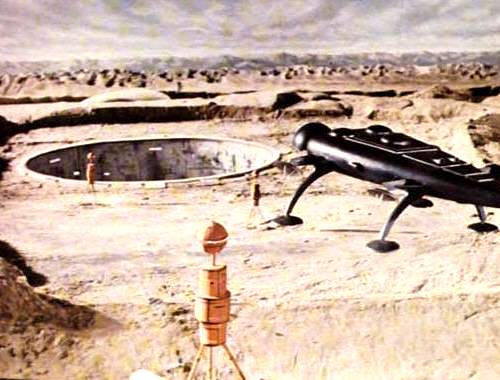
Schmidt is taken before Octavia and allowed to present his case. Arrogant as usual, Octavia refuses to listen, and the Earthman is taken away cursing that soon they will be pleading for his expertise. He is proven correct when the air ducts gradually become blocked by the accumulation of dissolving debris. At first, the women turn to their Prediction Computer that keeps insisting there is nothing wrong. In a last desperate hope, they consult Liz to research the problem and hopefully find a solution. She in turn demands that Schmidt be brought in as her assistant, although once work begins it is really the other way round.
Despite protest from Octavia, Schmidt carefully examines the city’s structure and discovers a new air purification system that is causing the problem. Water particles, falling through a mixture of gasses from the chemical waste and the air purifier itself, combines separate components to form a deadly acid rain. Thankful for the salvation, the president expresses her gratitude by granting Schmidt a release from prison, although she still can’t acknowledge the Earthman’s intellect. She declares that the scientist came to his conclusions by guessing.
Soon afterward, the Medusan president falls badly ill. Liz determines that she is suffering from an Earth cold virus that she caught from Liz. A spacecraft is launched that retrieves Professor Evans and brings him from Earth to Medusa. He agrees to cure the president but demands that all Earth prisoners are to be released. Having no choice, the Medusans agree. Evans cures the president who honors the agreement. Evans is returned to Earth.
On Earth, Shem has begun a relationship with an Earth woman, Rose, who gives him sanctuary. The police have begun actively hunting Adam and Shem and both are running out of places to hide. The experience proves beneficial for Shem who finally understands how two people can be together without one of them needing to be dominant and the other degraded.
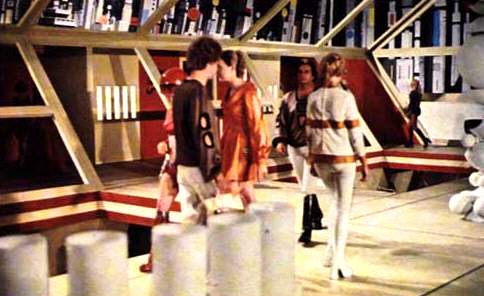
Things are changing on Medusa as well. Exerting her influence, the president has Liz assigned to a new job, checking over abandoned experiments beneath the Medusan city. Whilst searching through some old records with Schmidt, she enters a dark, dusty room, only to become trapped as a sliding door closes behind her. All her efforts to open it prove useless. Slowly, she realizes that she is not alone.
Several box-like shapes advance through the gloom. When they emerge into the meager light, she recognizes them as crudely built robots. The robots don’t mean to harm her. They want her affection, indefinitely. Still a bit shaken, she investigates and learns that they are the remnants of an unsuccessful experiment that was never completed. In it, machines were implanted with emotions, a process the Medusans never really mastered. They left the byproduct of their trial runs locked away in this vault. Schmidt manages to break through into the vault and rescues Liz. The robots offer no resistance and seemed resigned to their fate of loneliness.
Now freed, Schmidt and Liz opt to return to Earth. Octavia volunteers to return the Earthlings and takes the opportunity to retrieve Adam and Shem. On the return trip, the Nemesis is attacked by a mysterious vessel that Octavia recognizes as belonging to the Medusans’s age old natural predator, a reptilian life form that frequently troubled them in the distant past. The reptiles cripple the Nemesis, leaving it vulnerable to attack. The enemy prepares for an easy kill.
Out of nowhere, another Medusan vessel emerges and engages the enemy craft. Octavia is stunned to learn it is Fulvia who convinced Adam and Shem to return to Medusa. Realizing that Earth life is not for them, the two male Medusans are hoping to inspire social change on their own world and have decided to return peacefully. During the battle, the reptiles deliver a series of crippling blows to the second Medusan vessel. In the confusion, Adam takes over the controls and retaliates, destroying the enemy. Octavia thanks Fulvia for saving them only to learn that Adam, a man, has saved her. Reluctantly she voices her gratitude, albeit much against her principles.
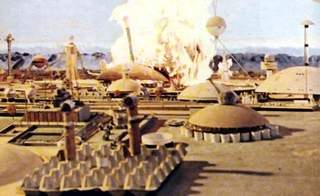
The reptilian race has been searching for the lost planet, Medusa. Although they haven’t yet located the planet itself, the contact with the Nemesis proved that Medusa was in the area. These monsters plan to attack Medusa and annihilate everyone there. Faced with Adam’s example that shows that men can indeed be taught to fight, the Medusans put aside their cultural differences and prepare to meet the reptiles should they locate the wandering planet.
Star Maiden’s feminist message was largely undercut by its presentation. To try to gain a regular network slot, the show featured attractive women in revealing costumes and their at least better-than-average docile man-servants. Medusa was shown as a planet without children or old people. In the episode, “Test for Love”, Liz is attached to a machine known as the sexometer, which works on a extension of the mind. On a nearby large video screen we see a muscle-bound, macho, blond German guy. Such incidents were commonplace throughout the series and conveyed the unintentional message that if women ever did get to control things, they would create a world controlled by sex—which might not have been a bad thing.
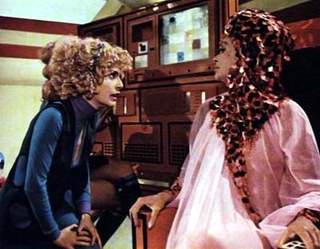
The Season One ending indicated that the production team planned to make another season. Had the story continued, Star Maidens would likely have wandered away from its original premise of forcing the viewer to consider the implications of issues like sexual discrimination, role reversal, and environmentalism. By the end of the very short first season, viewers were already finding the core messages of Star Maidens a bit tiresome. To be fair, the writers did an outstanding job creatively bringing the concepts to life, but the message was delivered a bit too strongly and didn’t vary much. Viewers fully understood the feminist premise of the show after the first episode. After that, the concepts came across as a bit preachy to a base of viewers that wasn’t fond of the real meaning behind Star Maidens in the first place.
Star Maiden’s impact was also reduced by its extremely low budget. Shot on low-quality 16mm film, the picture was too grainy for many viewers. Many ITA regions didn’t bother to show the series at all. Combined with the fact that the series couldn’t gain a regular network timeslot, with new episodes released haphazardly, it’s clear why this show didn’t take off. The few financial backers withdrew their support after filming of the first 13 episodes were completed. The owners made several attempts to get the show syndicated but the effort proved fruitless.
Star Maidens did manage to produce some jigsaw puzzles, a couple of coloring and sticker-fun books, an annual and a paperback written by Ian Watson from Corgi which contained adaptations of most of the key episodes.
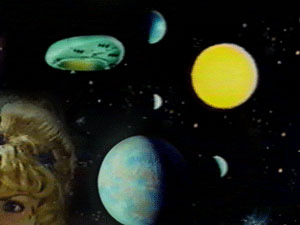
Despite its flaws, Star Maidens should be credited for taking a revolutionary approach to space opera. Politically motivated from the onset, the series did provide some good science fiction moments that make it worthy or viewing–if you can find a copy of this extremely rare series on VHS or DVD.
– written by Russell Sanders